文章目录
12.7 list容器
12.7.1 list基本概念
功能: 数据进行链式存储
链表(list): 是一种物理存储单元上非连续的存储结构,数据元素的逻辑顺序是通过链表中的指针链接实现的。
链表的组成:链表是有一些列结点组成
结点的组成:一个是存储数据的数据域,另一个是存储下一个结点地址的指针域
STL中的链表是一个双向循环链表
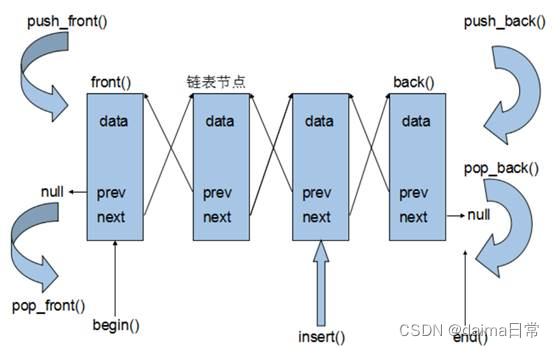
单链表结构如下:
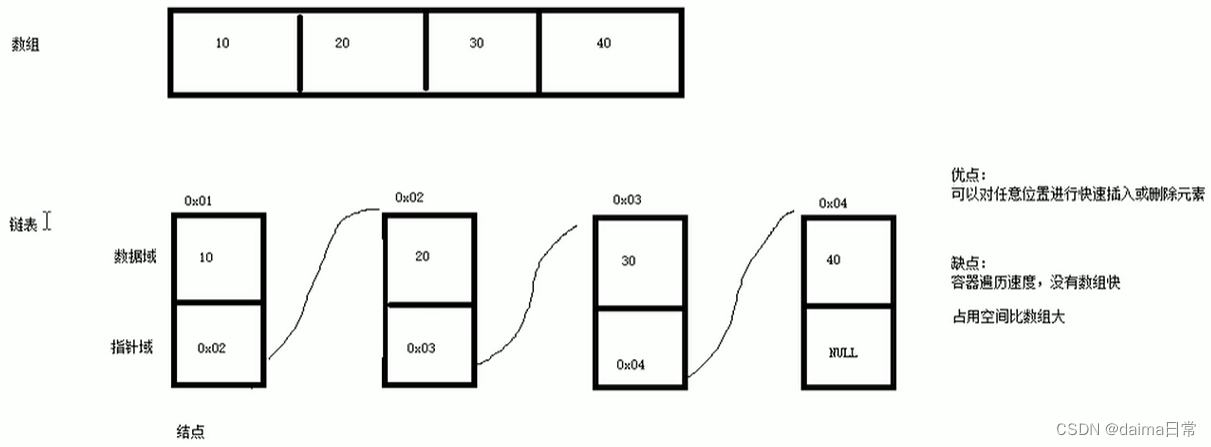
由于链表的存储方式并不是连续的内存空间,因此链表list中的迭代器只支持前移和后移,属于双向迭代器
list的优点:
- 采用动态存储分配,不会造成内存浪费和溢出
- 链表执行插入和删除操作十分方便,修改指针即可,不需要移动大量元素
list的缺点:
- 链表灵活,但是空间(指针域)和时间(遍历)额外耗费较大。
list有一个重要的性质,插入操作和删除操作都不会造成原有list迭代器的失效,这在vector是不成立的。
总结:STL中list和vector是两个最常被使用的容器,各有优缺点。
12.7.2 list构造函数
功能描述:
- 创建list容器
函数原型:
- list list; //list采用模板类实现,对象的默认构造形式
- list<beg,end>; //构造函数将[beg,end]区间中的元素拷贝给本身
- list(n,elem); //构造函数将n个elem拷贝给本身
- list(const list &lst); //拷贝构造函数
示例代码:
#include<iostream>
using namespace std;
#include<list>
//list 容器构造函数
void printList(const list<int>& L)
{
for (list<int>::const_iterator it = L.begin(); it != L.end(); it++)
{
cout << *it << " ";
}
cout << endl;
}
void test01()
{
//1、创建list容器
list<int >L1;// 默认构造
//2、添加数据
L1.push_back(10);
L1.push_back(20);
L1.push_back(30);
L1.push_back(40);
//3、遍历容器
printList(L1);
//区间方式构造
list<int>L2(L1.begin(), L1.end());
printList(L2);
//拷贝构造
list<int>L3(L2);
printList(L3);
//n个elem
list<int>L4(10, 9);
printList(L4);
}
int main()
{
test01();
system("pause");
return 0;
}
运行结果:

总结:list构造方式同其他几个STL常用容器一样,熟练掌握即可。
12.7.3 list赋值和交换
功能描述:
- 给list容器进行赋值,以及交换list容器
函数原型:
- assign(beg, end); //将(beg,end)区间中的数据拷贝赋值给本身
- assign(n, elem); //将n个elem拷贝赋值给本身
- list& operator=(const list &lst); //重载等号操作符
- swap(list); //将lst与本身的元素交互
示例代码:
#include<iostream>
using namespace std;
#include<list>
//list容器赋值和交换
void PrintList(list<int>& L)
{
for (list<int>::const_iterator it = L.begin(); it != L.end(); it++)
{
cout << *it << " ";
}
cout << endl;
}
//赋值
void test31()
{
list<int>L1;
L1.push_back(10);
L1.push_back(20);
L1.push_back(30);
L1.push_back(40);
PrintList(L1);
list<int>L2;
L2 = L1; //operator=赋值
PrintList(L2);
list<int>L3;
L3.assign(L2.begin(), L2.end());
PrintList(L3);
list<int>L4;
L4.assign(10, 99);
PrintList(L4);
}
void test32()
{
list<int>L1;
L1.push_back(10);
L1.push_back(20);
L1.push_back(30);
L1.push_back(40);
list<int>L2;
L2.assign(10, 100);
cout << "交换前:" << endl;
PrintList(L1);
PrintList(L2);
L1.swap(L2);
cout << "交换后:" << endl;
PrintList(L1);
PrintList(L2);
}
int main()
{
//test31();
test32();
system("pause");
return 0;
}
运行结果:
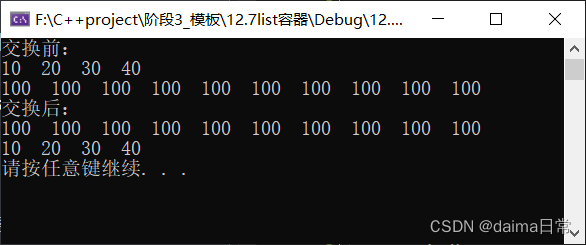
总结:
- list赋值和交换操作能够灵活运用即可。
12.7.4 list大小操作
功能描述:
- 对list容器的大小进行操作
函数原型:
- size(); //返回容器中的元素的个数
- empty(); //判断容器是否为空
- resize(num); //重新指定容器的长度为num,若容器变长,则以默认值(0)填充新位置,
//如果容器变短,则末尾超出容器长度的元素被删除
- resize(num,elem); //重新指定容器的长度为num,若容器变长,则以elem填充新位置,
//如果容器变短,则末尾超出容器长度的元素被删除
示例代码:
#include<iostream>
using namespace std;
#include<list>
//list容器大小操作
void printList3(const list<int>& L)
{
for (list<int>::const_iterator it = L.begin(); it != L.end(); it++)
{
cout << *it << " ";
}
cout << endl;
}
void test31()
{
list<int>L1;
L1.push_back(10);
L1.push_back(20);
L1.push_back(30);
L1.push_back(40);
printList3(L1);
if (L1.empty())
{
cout << " L1为空" << endl;
}
else
{
cout << " L1不为空" << endl;
cout << "L1的元素个数为:" << L1.size()<< endl;
}
//重新指定大小
//变长
//L1.resize(100);
L1.resize(10, 100);
printList3(L1);
//缩短
L1.resize(2);
printList3(L1);
}
int main()
{
test31();
system("pause");
return 0;
}
运行结果:
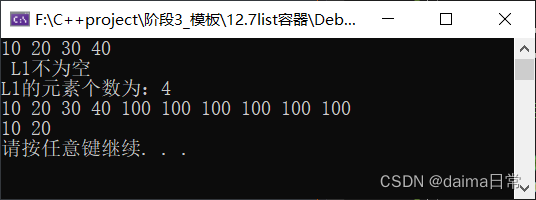
总结:
- 判断是否为空 ---- empty
- 返回元素个数 ---- size
- 重新指定个数 ---- resize
12.7.5 list插入和删除
功能描述:
- 对list容器进行数据的插入和删除
函数原型:
- push_back(elem); //在容器尾部加入一个元素
- pop_back(); //删除容器中最后一个元素
- push_front(elem); //在容器开头插入一个元素
- pop_front(); //从容器开头移除第一个元素
- insert(pos,elem); //在pos位置插elem元素的拷贝,返回新数据的位置。
- insert(pos,n,elem); //在pos位置插入n个elem数据,无返回值。
- insert(pos,beg,end);//在pos位置插入[beg,end)区间的数据,无返回值。
- clear(); //移除容器的所有数据
- erase(beg,end); //删除[beg,end)区间的数据,返回下一个数据的位置。
- erase(pos); //删除pos位置的数据,返回下一个数据的位置。
- remove(elem); //删除容器中所有与elem值匹配的元素。
示例代码:
#include<iostream>
using namespace std;
#include<list>
//容器的插入和删除操作
/*
* push_back(elem);//在容器尾部加入一个元素
* pop_back();//删除容器中最后一个元素
* push_front(elem);//在容器开头插入一个元素
* pop_front();//从容器开头移除第一个元素
* insert(pos,elem);//在pos位置插elem元素的拷贝,返回新数据的位置。
* insert(pos,n,elem);//在pos位置插入n个elem数据,无返回值。
* insert(pos,beg,end);//在pos位置插入[beg,end)区间的数据,无返回值。
* clear();//移除容器的所有数据
* erase(beg,end);//删除[beg,end)区间的数据,返回下一个数据的位置。
* erase(pos);//删除pos位置的数据,返回下一个数据的位置。
* remove(elem);//删除容器中所有与elem值匹配的元素。
*/
void printList4(const list<int>& L)
{
for (list<int>::const_iterator it = L.begin(); it != L.end(); it++)
{
cout << *it << " ";
}
cout << endl;
}
void test41()
{
//1、创建容器
list<int>L;
//2、赋值操作
//头插
L.push_back(1);
L.push_back(2);
L.push_back(3);
//尾插
L.push_front(1);
L.push_front(2);
L.push_front(3);
printList4(L);
//尾删
L.pop_back();
//32112
printList4(L);
//头删
L.pop_front();
printList4(L);
//insert插入
//L.insert(L.begin(), 100);
//L.insert(L.begin(),10, 100);
//printList4(L);
//insert插入
list<int>::iterator it = L.begin();
L.insert(++it, 99);
//2 99 1 1 2
printList4(L);
//删除
it = L.begin();
L.erase(++it);
//L.erase(it);
printList4(L);
//移除
L.push_back(10000);
L.push_back(10000);
L.push_back(10000);
L.push_back(10000);
printList4(L);
L.remove(10000);
printList4(L);
//清空
L.clear();
printList4(L);
}
int main()
{
test41();
system("pause");
return 0;
}
运行结果:
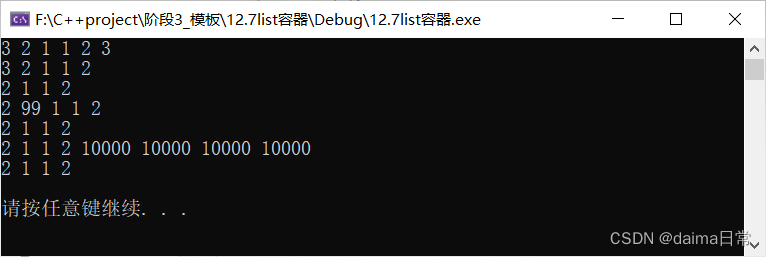
总结:
- 尾插 — push_back
- 尾删 — pop_back
- 头插 — push_front
- 头删 — pop_front
- 插入 — insert
- 删除 — erase
- 移除 — remove
- 清空 — clear
12.7.6 list数据存取
功能描述:
- 对list容器中数据进行存取
函数原型:
- front(); //返回第一个元素
- back(); //返回最后一个元素
示例代码:
#include<iostream>
using namespace std;
#include<list>
//list容器 数据存取
void test51()
{
list<int>L;
L.push_back(10);
L.push_back(20);
L.push_back(30);
L.push_back(40);
//L[0]; 不可以用[]访问list容器中的元素
//L.at(0); 不可以使用at方式访问list容器中的元素。
//原因是list本质是链表,不是用连续线性空间存储数据,迭代器也是不支持随机访问数据
cout << " 第一个元素为:" << L.front() << endl;
cout << " 最后一个元素为:" << L.back() << endl;
//验证迭代器是不支持随机访问的
list<int>::iterator it = L.begin();
//it = it + 1; 报错说明不支持随机访问
it--; //支持双向访问
it++;
}
int main()
{
test51();
system("pause");
return 0;
}
运行结果:

总结:
- list容器中不可以通过[]或者at方式访问数据,原因数据存储不连续
- 返回第一个元素 ---- front
- 返回最后一个元素 — back
12.7.7 list 反转和排序
功能描述:
- 将容器中的元素反转,以及将容器中的数据进行排序
函数原型:
- reverse(); //反转链表
- sort(); //链表排序
示例代码:
#include<iostream>
using namespace std;
#include<list>
#include<algorithm>
//list容器反转和排序
void printList6(const list<int>& L)
{
for (list<int>::const_iterator it = L.begin(); it != L.end(); it++)
{
cout << *it << " ";
}
cout << endl;
}
void test61()
{
list<int>L;
L.push_back(1);
L.push_back(3);
L.push_back(2);
L.push_back(4);
cout << "反转前:" << endl;
printList6(L);
//反转
L.reverse();
cout << "反转后:" << endl;
printList6(L);
}
//回调函数
bool myCompare(int v1, int v2)
{
//降序 就让第一数 > 第二个数
return v1 > v2;
}
//排序
void test62()
{
list<int>L;
L.push_back(1);
L.push_back(3);
L.push_back(2);
L.push_back(4);
cout << "排序前:" << endl;
printList6(L);
//所有不支持随机访问的迭代器的容器,不可以使用标准算法
//不支持随机访问迭代器的容器,内部会提供对应一下算法
//sort(L.begin(), L.end());
L.sort(); //默认是升序,从小到大排序
cout << "排序后:" << endl;
printList6(L);
// 降序
L.sort(myCompare);
printList6(L);
}
int main()
{
//test61();
test62();
system("pause");
return 0;
}
运行结果:
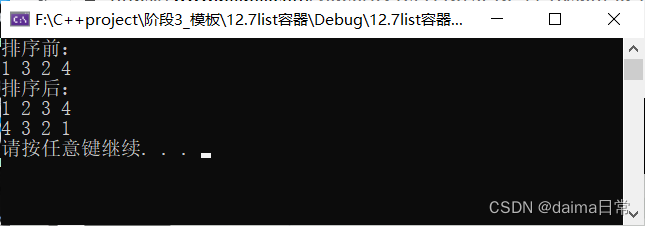
总结:
- reserse ---- 反转
- sort ---- 排序(成员函数)
12.3.8 排序案例
案例描述:将Person自定义数据类型进行排序,Person中属性有姓名,年龄,身高
排序规则:按照年龄进行升序,如果年龄相同按照身高进行降序
示例代码:
#include<iostream>
using namespace std;
#include<list>
#include<string>
/*
案例描述:将Person自定义数据类型进行排序,Person中属性有姓名,年龄,身高
排序规则:按照年龄进行升序,如果年龄相同按照身高进行降序
*/
class Person
{
public:
string m_name;
int m_age;
int m_height;
Person(string name,int age,int height)
{
m_name = name;
m_age = age;
m_height = height;
}
};
//void printList7(list<int> &L)
//{
// for (list<Person>::iterator it = L.begin(); it != L.end(); it++)
// {
// cout << "姓名:" << (*it).m_name << " 年龄:" << (*it).m_age << " 身高:" << (*it).m_height << endl;
// }
// cout << endl;
//}
//指定排序规则
bool comparePerson(Person& p1, Person& p2)
{
//按照年龄 升序
if (p1.m_age == p2.m_age)
{
//年龄相同,按照升高降序
return p1.m_height > p2.m_height;
}
return p1.m_age < p2.m_age;
}
void test71()
{
list<Person>L; //创建容器
//准备数据
Person p1("刘备", 35, 175);
Person p2("曹操", 45, 180);
Person p3("孙权", 40, 170);
Person p4("赵云", 25, 190);
Person p5("张飞", 35, 160);
Person p6("关羽", 35, 200);
//向容器中添加数据
L.push_back(p1);
L.push_back(p2);
L.push_back(p3);
L.push_back(p4);
L.push_back(p5);
L.push_back(p6);
for (list<Person>::iterator it = L.begin(); it != L.end(); it++)
{
cout << "姓名:" << (*it).m_name << " 年龄:" << (*it).m_age << " 身高:" << (*it).m_height << endl;
}
//排序
cout << "--------------------------------------------" << endl;
cout << "排序后:" << endl;
L.sort(comparePerson);
for (list<Person>::iterator it = L.begin(); it != L.end(); it++)
{
cout << "姓名:" << (*it).m_name << " 年龄:" << (*it).m_age << " 身高:" << (*it).m_height << endl;
}
}
int main()
{
test71();
system("pause");
return 0;
}
运行结果:
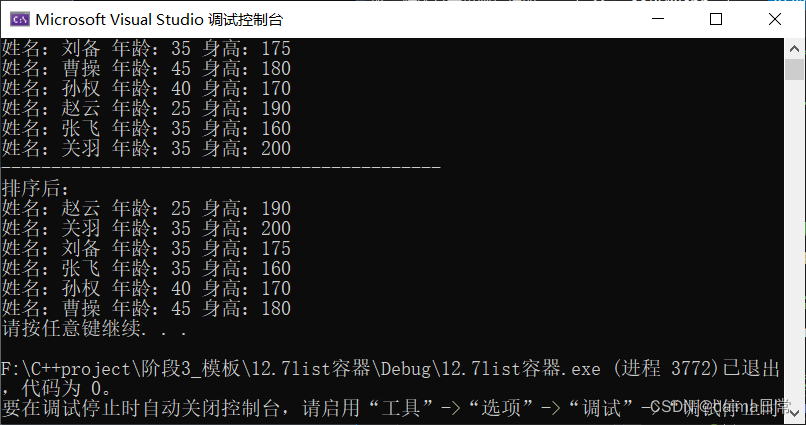
总结:
- 对于自定义数据类型,必须要指定排序规则,否则编译器不知道如何进行排序
- 高级排序只是在排序规则上进行一次逻辑规则制定,并不复杂。
如果对你有帮助的话,请不要忘了给我一点点点…支持 ( ^ o ^)/~
本文含有隐藏内容,请 开通VIP 后查看